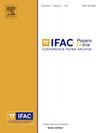Multi-Fidelity Surrogate Model for Representing Hierarchical and Conflicting Databases to Approximate Human-Seat Interaction⁎
Q3 Engineering
引用次数: 0
Abstract
It has been shown that working with databases from heterogeneous sources of varying fidelity can be leveraged in multi-fidelity surrogate models to enhance the high-fidelity prediction accuracy or, equivalently, to reduce the amount of high-fidelity data and thus computational effort required while maintaining accuracy. In contrast, this contribution leverages low-fidelity data queried on a larger feature space to realize data-driven multi-fidelity surrogate models with a fallback option in regimes where high-fidelity data is unavailable. Accordingly, methodologies are introduced to fulfill this task and effectively resolve the contradictions, that inherently arise in multi-fidelity databases. In particular, the databases considered in this contribution feature two levels of fidelity with a defined hierarchy, where data from a high-fidelity source is, when available, prioritized over low-fidelity data. The proposed surrogate model architectures are illustrated first with a toy problem and further examined in the context of an engineering use case in autonomous driving, where the human-seat interaction is evaluated using a data-driven surrogate model, that is trained through an active learning approach. It is shown, that two proposed architectures achieve an improvement in accuracy on high-fidelity data while simultaneously performing well where high-fidelity data is unavailable compared to a naive approach.
表示层次和冲突数据库以近似人座交互的多保真代理模型
研究表明,使用来自不同保真度的异构数据源的数据库可以在多保真度代理模型中加以利用,以提高高保真度预测精度,或者,等效地,减少高保真度数据的数量,从而在保持准确性的同时减少所需的计算工作量。相比之下,该贡献利用在更大的特征空间上查询的低保真度数据来实现数据驱动的多保真度代理模型,并在高保真度数据不可用的情况下提供回退选项。因此,本文引入了一些方法来完成这一任务,并有效地解决了多保真度数据库中固有的矛盾。特别是,本文中考虑的数据库具有两个级别的保真度,具有已定义的层次结构,其中来自高保真度源的数据在可用时优先于低保真度数据。提出的代理模型架构首先通过一个玩具问题进行说明,并在自动驾驶的工程用例背景下进一步检查,其中使用数据驱动的代理模型评估人与座椅的交互,该模型通过主动学习方法进行训练。结果表明,与朴素的方法相比,两种提出的架构在高保真数据上实现了精度的提高,同时在高保真数据不可用的情况下表现良好。
本文章由计算机程序翻译,如有差异,请以英文原文为准。
求助全文
约1分钟内获得全文
求助全文
来源期刊

IFAC-PapersOnLine
Engineering-Control and Systems Engineering
CiteScore
1.70
自引率
0.00%
发文量
1122
期刊介绍:
All papers from IFAC meetings are published, in partnership with Elsevier, the IFAC Publisher, in theIFAC-PapersOnLine proceedings series hosted at the ScienceDirect web service. This series includes papers previously published in the IFAC website.The main features of the IFAC-PapersOnLine series are: -Online archive including papers from IFAC Symposia, Congresses, Conferences, and most Workshops. -All papers accepted at the meeting are published in PDF format - searchable and citable. -All papers published on the web site can be cited using the IFAC PapersOnLine ISSN and the individual paper DOI (Digital Object Identifier). The site is Open Access in nature - no charge is made to individuals for reading or downloading. Copyright of all papers belongs to IFAC and must be referenced if derivative journal papers are produced from the conference papers. All papers published in IFAC-PapersOnLine have undergone a peer review selection process according to the IFAC rules.
 求助内容:
求助内容: 应助结果提醒方式:
应助结果提醒方式:


